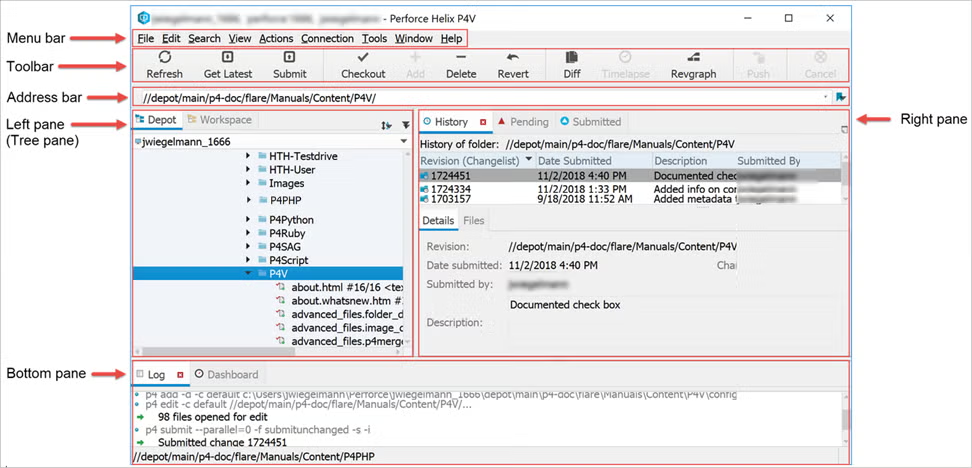Navigating P4V
This section helps you get familiar with P4V terminology and layout and walks you through basic tasks such as updating status information, modifying views, and accessing administration tools.
Terminology
P4V menus and forms use a general approach to versioning terminology and actions, to ensure that users with a variety of backgrounds can best understand what to do. If you have experience with P4Win or the P4 command line, note the following differences in terminology in P4V.
| Helix server term | P4V term |
|---|---|
|
Client |
Workspace |
|
Sync |
Get revision |
|
Open for edit |
Check out |
|
Open for add/delete |
Mark for add/delete |
Layout
P4V displays one main window with three panes: the left pane, which is also called the Tree pane; the right pane, which is where you do most of your work in P4V; and the bottom pane, which displays log and dashboard information. The following figure illustrates the different elements in the P4V user interface. They are described in detail below.

- Menu bar: Provides access to all available options.
-
Toolbar: Provides quick access to a subset of actions and tools available from the menu bar. To get information about a toolbar item or other object in P4V, move the mouse pointer over the object. P4V displays a small window (tooltip) containing status or explanatory information about the object. P4V makes extensive use of tooltips.
-
Address bar: Lets you navigate to specific folders and files in the depot and in your workspace. You can copy from and paste into the address bar. To navigate to any of the ten most-recent locations, select from the drop-down list:

-
Left pane (tree pane): Includes the following tabs:
- Depot Tree: Shows all of the files in the depot. To view the contents of a folder in the right-hand pane, click on that folder, and select View > Files in Folder.
- Workspace Tree: Shows the files on your computer, including files that are not in the depot.
- Right pane: Contains tabs for working with changelists, labels, workspaces, users, jobs, streams, and branches. To display a tab, click the corresponding button on the toolbar or choose it from the View menu. At the bottom of the right pane, the Details tab displays details about the current selected object. To view multiple Details tabs (for example to compare two objects), choose View > Tear Off.
- Bottom pane: Includes the following tabs:
Log tab: Displays the commands issued by P4V. To display this pane, choose View > Log.
Dashboard pane: Displays details about the status of your workspace and provides quick links for common tasks.
To display the dashboard, choose View > Dashboard. To configure the tasks displayed in the dashboard, click the Settings button
 in the top right corner of the tab.
in the top right corner of the tab.
-
Context menu: To display the context menu for an object on a Mac, option-click or click and hold. On Linux and Windows, right-click. (Note that this help system uses the platform-independent terminology "right-click" when instructing you to display a context menu.)
Update status information
P4V
indicates file information and status using a set of icons and badges. To obtain updated status
information and refresh the display,
P4V
periodically queries Helix server. To force a refresh operation, click ![]() .
.
Modify views
You can modify the way that information is presented in P4V’s panes and tabs. At the top of these panes and tabs, you can see one or more of the following buttons:
-
 Bookmarks
Bookmarks
Bookmarks act like shortcuts to locations in the tree. Set a bookmark by right-clicking on a directory and selecting Bookmark. You can then use this dropdown link to go to that location.
For more information, see Bookmarking files.
-
 Sort order
Sort order
Use this drop-down button to sort the order of the list that you are viewing. The sort options are shown when you click the button.
-
 Filter
Filter
This drop-down button allows you to filter your view in the following ways:
- Show or hide different types of files, such as deleted files and/or local files.
- Search for files and specs by various criteria and save those filters for reuse.
- In the Tree pane, "re-anchor" your tree to the bookmarks that you have created. If you select a bookmark from this list, that bookmark location becomes the top of your tree view.
For more information about filters, see Searching and filtering.
-
 Tear Off
Tear Off
This button allows you to "tear off" the current view. This is useful for comparing two different forms side-by-side. Once you have torn off a view, you can close the tear-off by simply closing that window.
-
 File list view
File list view
On the Files in Folder tab and the History tab (when viewing file history), use this icon to view files listed by file name or as thumbnails.






